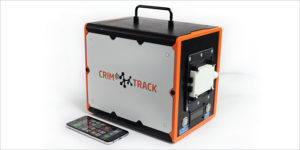Dogs have an eminent sense of smell. Their snouts use a specific sniffing technique which almost grabs hold of scents. Elephants’ snouts are even better than those of dogs, but obviously these are attached to elephants which are difficult to carry around. Consequently, today dogs are employed to track narcotics, money and explosives. Sometimes dogs are able to sense explosives in very small doses, however, they are not always 100 percent reliable as they are also sensitive to changes in their surroundings. A technological solution is therefore to be preferred in the tracking of stocks of narcotics or explosive materials.
The CRIM-TRACK sniffer system
Researchers at DTU have developed the prototype of a chip able to sniff molecular structures from a number of known substances. A special camera visualises the results from the chip (with 24 megapixels per 15 second) and newly developed software interprets these images according to changes in colour (i.e. the difference between two pictures), caused by the impact of the scents in the air.
“We have conducted experiments by sucking air from smaller containers like e.g. handbags or pieces of luggage and from large industrial sized containers typically used for smuggling. In both cases, we arrived at promising results”, says Mogens Havsteen Jakobsen, Senior Researcher at DTU Nanotech.
By using the so-called colorimetric sensing technique, the artificial nose is able to detect different substances like explosives, narcotics, the ripeness of cheese, rotten meat and fish, the quality of wine and coffee or bad indoor climate of a room.
A special focus on explosives
The project has specifically targeted explosives which are a growing safety risk in our society. The Chemical Division of the Danish Emergency Management Agency has been an important collaborator because they are authorised to produce and handle explosives.
“We have test laboratories which have been made available during the course of the project”, says Jesper Mogensen, civil engineer and analysis chemist at the Chemical Division and therefore used to handling explosives.
“There will be some evident advantages in using a technology such as CRIM-TRACK, compared to the instruments available today,” Jesper Mogensen says. “Firstly, the preparation time is short in that what you largely need to do is switch on the tracker and use it. This is valuable time saved. Secondly and perhaps the most important advantage is the fact that the EOD (the Explosive Ordnance Disposal) does not need to collect a sample. Today when we are called to a ransacking if e.g. a kilo of white powder has been found and we have to analyse its chemistry by way of GC-MS (i.e. gas chromatography-mass spectrometry), a sample of the substance must be collected on a fibre. In other words, it is necessary to collect physically a sample with all the risks this entails. With DTU’s sniffer system, it is possible to collect samples in the air. It sniffs for the drug much like a dog and indicates whether there are any explosives or not. This will increase the safety of our EOD”.
Jesper Mogensen looks forward to the opportunity of using the system outside the test laboratory. “Within the last fortnight, there have been two callouts in which this technology might have been relevant”, the analysis chemist says.
From prototype to reality
Even though the first prototypes have now been produced and tested, there is still some way to go before we will see Mærsk containers or baggage carrousels in airports routinely checked by CRIM-TRACK.
“We are still a few steps short before we have the final device, but within a few years, it will be possible to have a fully developed system able to detect explosives and narcotics”, says Mogens Havsteen Jakobsen.
The researchers have already established a limited liability company and will attempt to commercialise DTU’s part of the sniffer system. In the next phase of the development, the system is to be refined and expanded with a wireless device, to make it possible to send the chip with a robot into surroundings which are to be examined for explosives and receive data from a safe distance.
Simultaneously, the newly-started company participates in a new H2020 application with DTU Nanotech, DTU Compute and DTU Chemical Engineering. The aim of the project is to further develop various technologies for detection in order to expose illegal laboratories for the production of homemade bombs and explosives and illegal drugs as early as possible.
Source: DTU Nanotech
